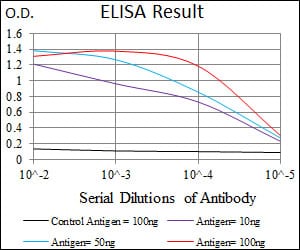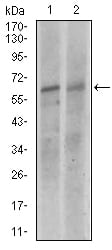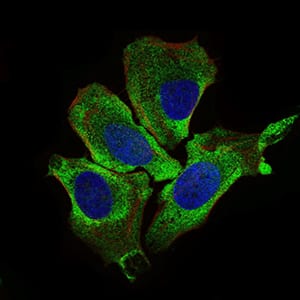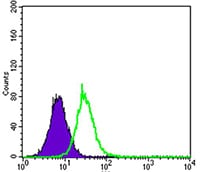



| WB | 咨询技术 | Human,Mouse,Rat |
| IF | 咨询技术 | Human,Mouse,Rat |
| IHC | 咨询技术 | Human,Mouse,Rat |
| ICC | 1/50 | Human,Mouse,Rat |
| FCM | 1/200 - 1/400 | Human,Mouse,Rat |
| Elisa | 1/10000 | Human,Mouse,Rat |
| Aliases | INrf2; KLHL19 |
| Entrez GeneID | 9817 |
| clone | 1F10B6 |
| WB Predicted band size | 69.7kDa |
| Host/Isotype | Mouse IgG1 |
| Antibody Type | Primary antibody |
| Storage | Store at 4°C short term. Aliquot and store at -20°C long term. Avoid freeze/thaw cycles. |
| Species Reactivity | Human,Mouse |
| Immunogen | Purified recombinant fragment of human KEAP1 (AA: 380-624) expressed in E. Coli. |
| Formulation | Purified antibody in PBS with 0.05% sodium azide. |
+ +
以下是3篇关于KEAP1抗体的参考文献,涵盖抗体应用及验证的摘要内容:
---
1. **文献名称**: "Characterization of KEAP1-NRF2 Antibody Specificity Using CRISPR/Cas9-Knockout Controls"
**作者**: Campbell, M.R. et al.
**摘要**: 该研究利用CRISPR/Cas9敲除KEAP1的细胞模型,验证了多种商业KEAP1抗体的特异性。通过Western blot和免疫荧光实验,发现部分抗体在KO模型中仍存在非特异性信号,提示选择抗体时需结合功能学验证。
---
2. **文献名称**: "KEAP1 Antibody Selection Impacts Oxidative Stress Pathway Analysis in Lung Cancer"
**作者**: Singh, A. et al.
**摘要**: 比较了5种KEAP1抗体在肺癌组织中的免疫组化(IHC)表现,发现不同克隆号抗体对KEAP1亚细胞定位(胞质/核)的检测结果存在差异,强调抗体选择对病理研究结果的影响。
---
3. **文献名称**: "Optimization of KEAP1 Detection in Murine Models Using Species-Specific Antibodies"
**作者**: Yamamoto, T. et al.
**摘要**: 研究指出部分KEAP1抗体在人源与鼠源样本中存在交叉反应性问题,通过比对不同物种的KEAP1蛋白序列,筛选出适用于小鼠模型的抗体,并优化了染色条件。
---
**备注**:建议优先选择经敲除验证(KO-validated)且注明克隆号的抗体,并参考目标样本类型(如人类/小鼠、冰冻/石蜡切片)进行选择。
×